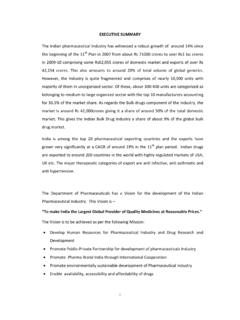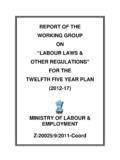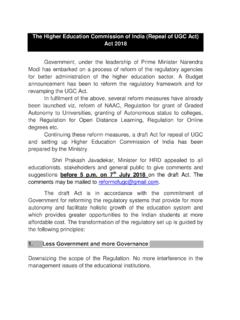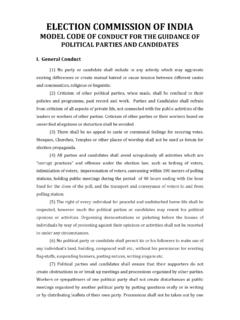Transcription of Twelfth Five Year Plan vol 1 - Planning Commission
1 Twelfth five year plan (2012 2017). Faster, More Inclusive and Sustainable Growth Volume I. Copyright Planning Commission ( government of india ) 2013. All rights reserved. No part of this book may be reproduced or utilised in any form or by any means, electronic or mechanical, including photocopying, recording or by any information storage or retrieval system, without permission in writing from the Planning Commission , government of india . First published in 2013 by SAGE Publications india Pvt Ltd B1/I-1 Mohan Cooperative Industrial Area Mathura Road, New Delhi 110 044, india SAGE Publications Inc 2455 Teller Road Thousand Oaks, California 91320, USA. SAGE Publications Ltd 1 Oliver's Yard, 55 City Road London EC1Y 1SP, United Kingdom SAGE Publications Asia-Pacific Pte Ltd 33 Pekin Street #02-01 Far East Square Singapore 048763. Published by Vivek Mehra for SAGE Publications india Pvt Ltd, Phototypeset in 11/13pt Minion Pro by RECTO Graphics, Delhi and printed at Saurabh Printers, New Delhi.
2 Library of Congress Cataloging-in-Publication Data india . Planning Commission Twelfth five year plan (2012/2017)/ Planning Commission , government of india . Volumes cm 1. india Economic Policy 1991 92. Finance, Public india . I. Title. '0512 dc23 2013 2013009870. ISBN: 978-81-321-1368-3 (PB). The SAGE Team: Rudra Narayan, Archita Mandal, Rajib Chatterjee and Dally Verghese Twelfth five year plan (2012 2017). Faster, More Inclusive and Sustainable Growth Volume I. Planning Commission government of india Thank you for choosing a SAGE product! If you have any comment, observation or feedback, I would like to personally hear from you. Please write to me at Vivek Mehra, Managing Director and CEO, SAGE Publications india Pvt Ltd, New Delhi Bulk Sales SAGE india offers special discounts for purchase of books in bulk. We also make available special imprints and excerpts from our books on demand. For orders and enquiries, write to us at Marketing Department SAGE Publications india Pvt Ltd B1/I-1, Mohan Cooperative Industrial Area Mathura Road, Post Bag 7.
3 New Delhi 110044, india E-mail us at Get to know more about SAGE, be invited to SAGE events, get on our mailing list. Write today to This book is also available as an e-book. YZ. iz kku ea kh Prime Minister Foreword The Twelfth plan period presents both challenges and opportunities. The plan commenced at a time when the global economy was going through a second financial crisis, precipitated by the sovereign debt problems of the Eurozone which erupted in the last year of the Eleventh plan . The crisis affected all countries including india . Our growth slowed down to percent in 2011-12 and the deceleration continued into the first year of the Twelfth plan , when the economy is estimated to have grown by only 5 percent. This poses an immediate challenge of bringing the economy back to a higher growth path. Short term downturns occur in all economies. They do not necessarily indicate an erosion of longer term potential, but they do call for urgent corrective action.
4 The Twelfth plan therefore emphasizes that our first priority must be to bring the economy back to rapid growth while ensuring that the growth is both inclusive and sustainable. The potential of the economy to grow much more rapidly is evident from the Eleventh plan experience, which produced an average growth rate of 8 percent for the period 2007-08 to 2011-12. This was lower than the Eleventh plan target of 9 percent, but higher than the Tenth plan achievement of percent and also the highest growth rate ever recorded by the Indian economy in any plan period. The slow down witnessed in the first year of the plan is partly due to the global environment, which has affected all countries, but it is also due to a number of domestic constraints which have arisen. While we cannot do much about the global slowdown, we can address domestic constraints and this must have top priority. The economy faces macro economic imbalances, because the fiscal deficit expanded sharply after 2008.
5 There has also been a parallel widening of the current account deficit of our balance of payments which is expected to reach about 5 percent of GDP in 2012-13. This must be contained as quickly as possible. A num- ber of infrastructure projects have run into implementation problems and this, combined with the depressed mood of investors in industrialized countries, has affected animal spirits of investors. The Twelfth plan has therefore proposed a two pronged strategy focusing initially on the need to bring the macro economic imbalances under control and to reverse the slow down, while also pushing for structural reforms in many areas that are critical for maintaining medium term growth. The government has commenced the process of macro-economic rebalancing. It is firmly commit- ted to bringing the fiscal deficit under control and a medium term road map for fiscal correction has been vi Foreword announced. This aims at reducing the Central government deficit to no more than 3 percent by the end of the plan period in line with the macro-economic projections in the plan .
6 The high current account deficit is another macro-economic aspect of imbalance. Our foreign exchange reserves position is strong, but the reserves cannot be a source for financing prolonged deficits. It is therefore essential to bring the current account deficit down to more manageable levels. The expansion in the current account deficit was partly on account of the expansion in the fiscal deficit and the targeted reduction in the fiscal deficit is an important instrument for bringing the current account deficit under control. It is expected to decline in 2013-14, but it will still be high. However, it will be on a perceptibly downward path, reaching comfortable levels in the next two years. This poses the challenge of having to ensure financing of a somewhat elevated deficit for two more years. This must be done through long term capital flows, including especially FDI. Strong signals have been given to assure foreign investors that the government is keen to attract both FDI and Fll flows in order to finance the current account deficit even as we work to reduce the size of the deficit over time.
7 Caps on the permitted level of FDI in a number of sectors have been relaxed, and a broader review of policies is being undertaken with a view to facilitate an easier flow of foreign investment. The government has also acted on the supply side to tackle implementation problems holding up large infrastructure projects. A Cabinet Committee on Investment has been established to deal with situations where clearances are unduly delayed and this has succeeded in removing many bottlenecks. This will acceler- ate clearance of projects and help revive the pace of investment which should bring about a reversal of the slowdown. The Twelfth plan has set a target of 8 percent growth over the five year period 2012-13 to 2016-17. With a growth of only 5 percent in the first year and perhaps percent in the second, it will require a very sharp acceleration in the later years to achieve an average of 8 percent over the entire plan period.
8 Growth will have to be pushed to over 9 percent in the last two years. The economy did grow at over 9 percent for five years before 2008, but that was at a time when the global economy was booming. To achieve this level over the next two years, given the uncertain prospects of the global economy in the years ahead, poses challenges. The plan therefore emphasizes that returning to 9 percent growth by the end of the plan period will not be easy. The plan document makes it amply clear that a return to high growth will not come from following a busi- ness as usual approach. It will require policy action on many fronts, by both the central and the state govern- ments. The plan provides a detailed outline of the key steps needed in each area. Some of the policy changes called for are difficult, but they are necessary if we want inclusive and sustainable growth. We need to acceler- ate growth in agriculture to continue the trend initiated in the Eleventh plan .
9 We need much faster growth in manufacturing to provide employment to our young and increasingly educated population which has high expectations and aspirations. We need to address the challenge of managing the infrastructure sectors to ensure that these sectors expand sufficiently to support growth. We also need to face up to the enormous chal- lenges posed by urbanization. In all this, we must keep in mind that growth must not only be rapid, it must be inclusive and sustainable. The benefits of growth must reach the SCs, STs, OBC, Minorities and other disadvantaged groups in our society. All these groups must get a fair share of the benefits of growth and must have a stake in the process. The issue of environmental sustainability cannot be ignored. We need a growth process that is consistent with protecting our environment. Foreword vii One of the problems with our plans in the past has been that they have focused on outlining an attractive future, with not enough focus on what is needed to achieve it and the consequences of failing in this regard.
10 Recognizing that outcomes will be the result of actions, the Twelfth plan , for the first time, has resorted to scenarios to indicate the implications of different types of behaviour. Our objective should be to achieve the scenario of strong inclusive growth which can yield an average growth rate of around 8 percent of GDP and significant improvements in various inclusiveness indicators. Significantly, the plan warns that if we fail to do what is necessary, we may slip into a scenario of Policy logjam which will lead to growth of 5 to percent, with a much worse outcome for inclusiveness. The objectives of the Twelfth plan are ambitious and achieving them will be difficult. This is a challenge for our democratic system. We have to prove that vigorously competitive politics in a democracy can achieve a sufficient consensus to be able to implement the difficult but necessary policy choices we face. This is a national challenge that the entire political and intellectual leadership of our country must come to grips with.















